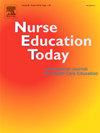Failure to thrive: A QuantCrit analysis of academic failure and everyday discrimination in undergraduate nursing education
IF 4.2
2区 医学
Q1 EDUCATION, SCIENTIFIC DISCIPLINES
引用次数: 0
Abstract
Background
Academic failure in nursing education is frequently framed as a student deficit, detached from the structural and institutional forces that shape educational outcomes. This framing obscures how racism, bias, and exclusionary evaluation practices influence who fails—and under what conditions.
Objective
This study examines the relationship between everyday discrimination and academic failure in undergraduate nursing education, using a Quantitative Critical Race Theory (QuantCrit) lens to foreground identity as a site of structural vulnerability.
Methods
A cross-sectional survey was conducted with 256 undergraduate nursing students at a Canadian university. Descriptive analyses, chi-square tests, t-tests, and logistic regression models were used to examine associations between everyday discrimination, academic failure, and social identity.
Results
Students who reported academic failure had higher levels of perceived everyday discrimination. Academic failure was more common among racialized students (54.4 %) compared to non-racialized students (38.5 %). The interaction of race and gender revealed that racialized women had over seven times the odds of academic failure compared to non-racialized men. Skills-based assessments were the most common site of reported failure.
Conclusions
These findings challenge the notion that student failure is solely due to deficits. Instead, they suggest that structural inequalities, particularly those based on race and gender, significantly impact academic outcomes. A QuantCrit perspective redefines failure as a consequence of institutional structures and power dynamics, influencing evaluation practices, faculty development, and equity accountability in nursing education.
未能茁壮成长:对本科护理教育中学业失败和日常歧视的定量分析。
背景:护理教育的学业失败通常被认为是学生不足,与影响教育成果的结构性和制度性力量脱节。这种框架模糊了种族主义、偏见和排斥性评估实践是如何影响谁失败的——以及在什么条件下失败的。目的:本研究探讨了护理本科教育中日常歧视与学业失败之间的关系,采用定量批判种族理论(QuantCrit)的视角,将身份作为结构脆弱性的一个场所。方法:采用横断面调查法对加拿大某大学护理专业本科学生256名进行调查。使用描述性分析、卡方检验、t检验和逻辑回归模型来检验日常歧视、学业失败和社会认同之间的关系。结果:报告学业失败的学生在日常生活中感受到的歧视程度更高。与非种族化学生(38.5%)相比,种族化学生(54.4%)的学业失败更为常见。种族和性别的相互作用表明,与非种族化的男性相比,种族化的女性学业失败的几率是其七倍多。基于技能的评估是最常见的失败报告。结论:这些发现挑战了学生失败仅仅是由于缺陷的观念。相反,他们认为,结构性不平等,尤其是基于种族和性别的不平等,会显著影响学业成绩。QuantCrit的观点将失败重新定义为制度结构和权力动态的结果,影响护理教育的评估实践,教师发展和公平责任。
本文章由计算机程序翻译,如有差异,请以英文原文为准。
求助全文
约1分钟内获得全文
求助全文
来源期刊

Nurse Education Today
医学-护理
CiteScore
6.90
自引率
12.80%
发文量
349
审稿时长
58 days
期刊介绍:
Nurse Education Today is the leading international journal providing a forum for the publication of high quality original research, review and debate in the discussion of nursing, midwifery and interprofessional health care education, publishing papers which contribute to the advancement of educational theory and pedagogy that support the evidence-based practice for educationalists worldwide. The journal stimulates and values critical scholarly debate on issues that have strategic relevance for leaders of health care education.
The journal publishes the highest quality scholarly contributions reflecting the diversity of people, health and education systems worldwide, by publishing research that employs rigorous methodology as well as by publishing papers that highlight the theoretical underpinnings of education and systems globally. The journal will publish papers that show depth, rigour, originality and high standards of presentation, in particular, work that is original, analytical and constructively critical of both previous work and current initiatives.
Authors are invited to submit original research, systematic and scholarly reviews, and critical papers which will stimulate debate on research, policy, theory or philosophy of nursing and related health care education, and which will meet and develop the journal''s high academic and ethical standards.
 求助内容:
求助内容: 应助结果提醒方式:
应助结果提醒方式:


